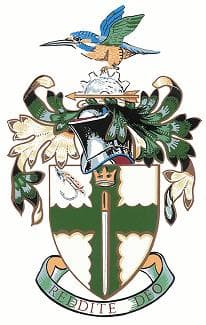Borough Crest
Arms were granted to Redditch Urban District Council by Letters Patent dated 15th December 1943. They could be blazoned:
Argent on a Cross engrailed Vert a Needle point downwards of the field eyed and ensigned with an Ancient Crown Or in the first quarter a Salmon-Fly in bend proper.
Crest
In front of a demi-Cogwheel thereon a Swift rising proper an Arrow fesswise Or
Motto
REDDITE DEO (Render to God/Redditch for God)
Redditch became a Borough on the 15th May 1980. New Letters Patent were issued dated 2nd March 1984 which exemplified the transfer of the Arms of the former Urban District Council to the new Borough. The Crest was altered slightly.
The Swift, very simply, became a Kingfisher. This was done at the request of the new Borough and reflected the growing association between Redditch and the most attractive of birds.
Redditch has grown from a hamlet near the Cistercian Abbey of Bordesley. The white of the shield is taken from the monks' habit. The Cross is a reference to St Stephen, patron of both the Abbey and the Parish Church. The green of the Cross commemorates Feckenham Forest. The Borough stands within this former Forest. The Ancient Crown alludes to King John who made the forest "Royal", and to his grandmother the Empress Maud who founded the Abbey in 1138. The needle and the salmon-fly mark the principal industries. The Crest refers also to important industries by showing a demi-cogwheel. The arrow is an obvious allusion to the River Arrow, which flows through Redditch. It is also a symbol of the speed and directness of modern road and air transport.
The Wreath that covers the join between Crest and Helm is of six twists of silk. White alternating with green. The Mantling that hangs down from the Wreath is green on top and white underneath. (The Mangling was originally used to keep the sun off the neck of the knight wearing the helm, or helmet.)
The motto is a quotation from Mark Chapter XII, Verse 17. "Reddite quae sunt Caesaris, Caesari; et quae Dei sunt, Deo" which means "Render to Caesar the things that are Caesar's and to God the things that are God's".
Heraldry, or Armoury to use the more accurate term, is a very old and thriving science. It was originally a method of identification. All knights looked alike in armour. Over the many centuries it has grown into an interesting and colourful subject that links not only the past to the present but the future too. Each Coat of Arms is a link between the bearer and the Head of State, it is thus quite an honour.
To use Arms one requires the consent of the Crown. In England and Wales the Sovereign delegates to the Earl Marshal of England, who works through the College of Arms. In Scotland Lord Lyon King of Arms looks after matters on this subject for the Sovereign.
Coats of Arms are described (blazoned) in the ancient language of heraldry which allows any armorist who reads it to know what is required. It is a mixture of Norman-French and English.
Anyone who wishes to know how they might apply for a Grant of Arms and the fees payable should contact whichever of the following applies:
England, Wales and Northern Ireland
The Duty Officer
The College of Arms
Queen Victoria Street
LONDON
EC4V 4BT
Scotland
The Rt Hon The Lord Lyon King of Arms
HM New Register House
EDINBURGH
EH1 3YT
The Irish Republic
The Chief Herald of Ireland
Dublin Castle
DUBLIN

Feedback & Share
Share this page on social media
